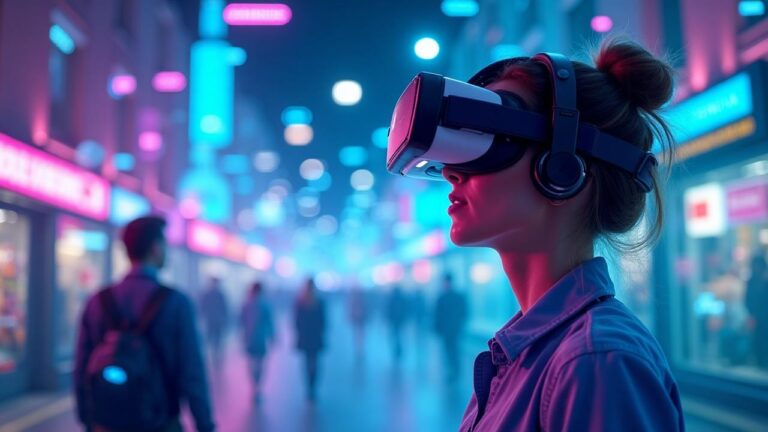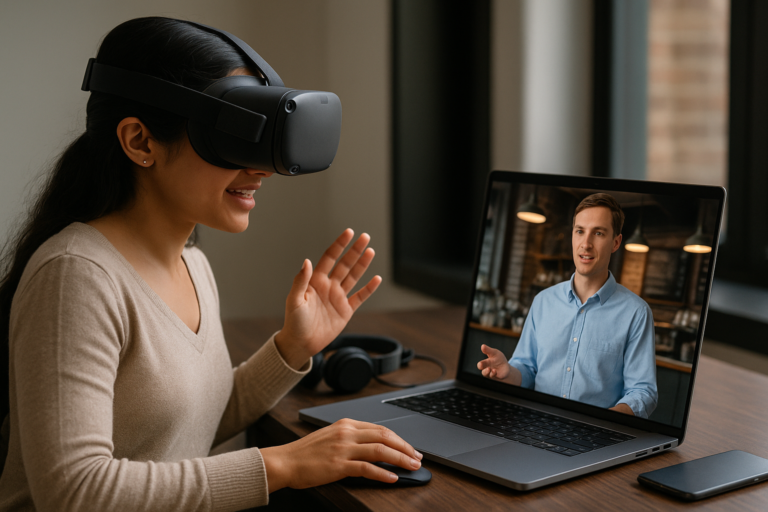
Discover how VR & holograms in English apps boost fluency, confidence, and accent training through immersive real-world practice.
In today’s fast-moving world, learning English isn’t just about reading grammar books or repeating phrases on an app. As the CEO of an IT company building an AI-driven English-speaking app, I often asked myself: What will make learning not only effective but unforgettable?
That question led us to VR and holographic technology. Imagine stepping into a virtual market in London, bargaining for fruits, or finding your way to the train station in New York all while wearing a VR headset. Instead of flat exercises, our learners now live the conversation. This is where pronunciation improves naturally, accents are polished, and confidence grows.
Why Did We Choose VR/AR for English Learning?
When we studied our users, one concern was clear: “I know the grammar, but I freeze when I speak.” VR and AR answered that pain point.
Real-world scenarios, zero fear: Users practice in lifelike settings without fear of embarrassment.
Accent training with holograms: A holographic tutor corrects mistakes instantly just like a personal coach.
Immersive memory building: Instead of memorizing words, learners experience them in action.
We partnered with a premium VR/AR solutions agency to integrate these features directly into our app. The result? User sessions became more engaging, our organic traffic grew, and our business scaled nearly 4x faster.

Will VR/AR Replace Traditional English Learning?
Not at all. It complements it. Think of it as moving from knowing English to living English. Textbooks teach rules, apps provide practice, but VR and holograms create real-world fluency.
For IT companies like ours, the lesson is simple: users don’t just want “apps,” they want experiences. By investing in immersive technology, we not only helped learners speak better we also built a brand users trust and love.

How 3D Rendering is Revolutionizing English Learning?
Imagine this: A young professional, Priya, stands in front of her computer screen, ready to take on a new challenge. She’s been using her English learning app for months, diligently going through grammar lessons, quizzes, and listening exercises. But there’s a problem whenever she has to speak in English, she freezes up. She knows the words, she knows the grammar, but when it’s time to speak, she struggles to sound natural.
What if she could actually practice English in real-world scenarios? What if she could interact with a 3D-rendered avatar of a native English speaker, helping her navigate a bustling street market in London or order a coffee at a New York café? This is where the magic of 3D rendering comes in.
As the CEO of an IT company creating an AI-driven English-speaking app, I’ve seen firsthand how 3D rendering can completely transform language learning. Let me take you through Priya’s journey of overcoming her speaking challenges with the help of 3D technology.
The Shift from Flat Screens to Lifelike Interactions
In traditional English learning apps, lessons often feel disconnected from reality. They’re static, two-dimensional, and lack the emotional depth needed for authentic practice. That’s where 3D-rendered environments break the mold.
In Priya’s case, instead of reading about ordering a coffee, she enters a virtual café. The scene feels lifelike: there’s the soft hum of conversation, the clink of coffee cups, and the distant sound of traffic outside. The barista, a 3D avatar, greets her in English, prompting Priya to respond. At first, she stumbles over her words. But the barista, always patient, helps her by repeating the sentence slowly, adjusting her tone and pronunciation. The real-time feedback feels as if Priya is in the moment, talking to a real person.
How 3D Rendering Enhances Pronunciation and Confidence?
For learners like Priya, pronunciation can be a major hurdle. Even if they know how to say a word, there’s often a gap between knowing and saying it correctly. 3D-rendered avatars solve this problem by offering a dynamic, interactive experience.
When Priya speaks to her virtual barista, the avatar’s lips move and their tone shifts to match real-life interactions. If Priya mispronounces a word, the avatar gently corrects her, showing the correct mouth movements in 3D. This visual cue is crucial for learning, as it bridges the gap between hearing the correct pronunciation and replicating it.
But the benefit doesn’t end there. Priya can also adjust the difficulty of her sessions, moving from simple conversations to more complex scenarios like giving directions or negotiating prices. Each 3D-rendered environment is designed to challenge her, pushing her to practice more and build confidence in her speaking abilities.
Immersive Language Learning with 3D Environments

One of the most powerful aspects of 3D rendering is how it immerses learners in real-world scenarios. Instead of memorizing vocabulary or listening to recordings, Priya can now engage in conversations that feel real.
The Future: A Blend of VR, Holograms, and Real-World Fluency
Will 3D-rendered avatars, VR, and holograms replace traditional English learning? Absolutely not. But they will complement it in ways that textbooks and flat-screen apps simply can’t.
By blending the solid foundation of grammar and vocabulary with immersive experiences, we’re helping learners go beyond the “book knowledge” and live the language. They’re not just memorizing words, they’re using them in real-life, 3D scenarios that challenge them to speak fluently, confidently, and naturally.
In the end, the future of English learning isn’t just about apps, it’s about creating experiences that make learners feel like they’re truly speaking English in the real world. By incorporating VR, holograms, and 3D rendering, we’re not just teaching English; we’re bringing it to life. And that’s a game changer.